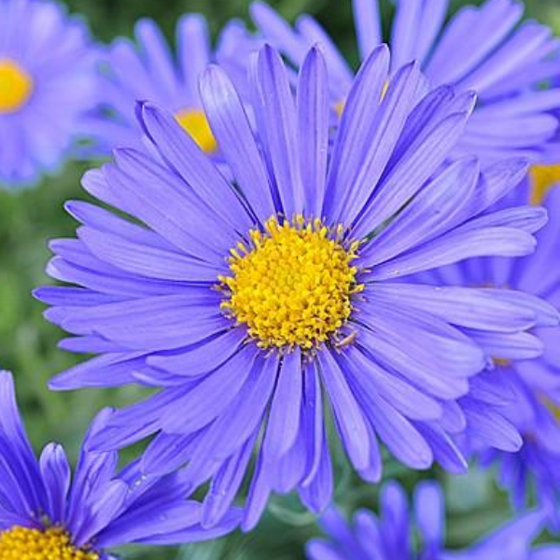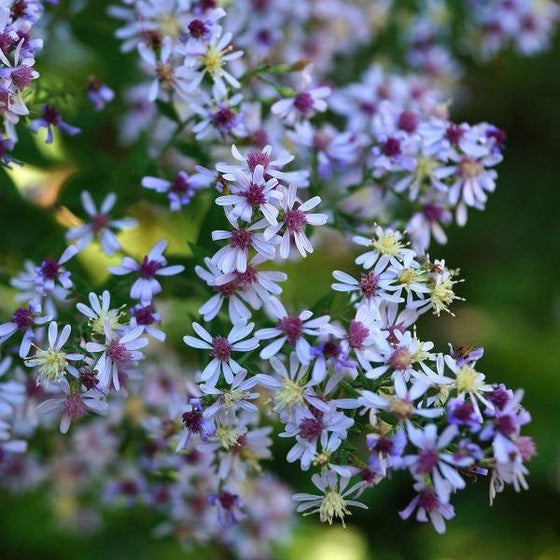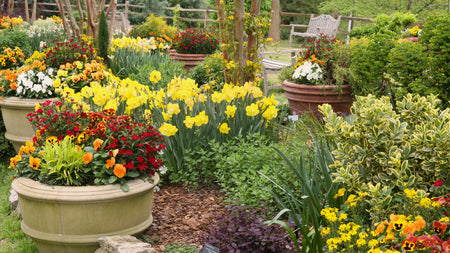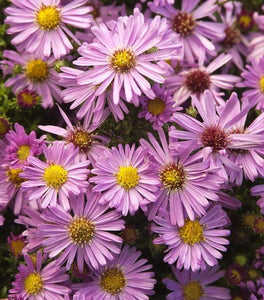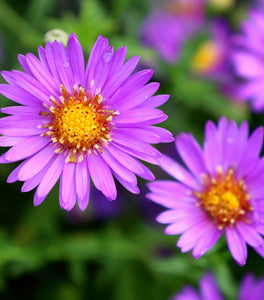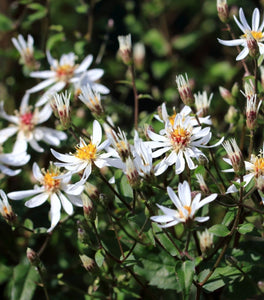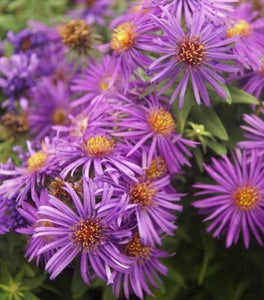
Images Depict Mature Plants
Brilliant Blue Fall Aster That Attracts Pollinators and Brightens Autumn Gardens
Stunning Late-Season Blue Blooms
Aster ‘Wood’s Blue’ brings the sky to your garden with a blanket of brilliant blue, daisy-like blooms from late summer through fall. As many plants begin to fade, this compact perennial explodes with color, drawing butterflies, bees, and late-season pollinators in droves. Each flower features a golden-yellow center surrounded by clear blue petals that glow in the autumn sun.
Compact Habit for Borders and Containers
Growing just 12 to 18 inches tall, Wood’s Blue Aster forms a dense, mounded shape that’s ideal for edging pathways, brightening front borders, or filling patio containers. Its strong stems hold up beautifully in wind and rain, keeping your display neat and full of color through the season. This tidy growth makes it a perfect choice for small gardens or container arrangements.
Easy-Care, Hardy, and Deer Resistant
This low-maintenance perennial thrives in full sun and well-drained soil. Once established, it tolerates short dry periods and requires only regular watering during bloom time. Deer and rabbits tend to avoid it, while butterflies can’t resist — a perfect balance for a carefree, wildlife-friendly garden.
A Fall Must-Have for Pollinator and Cottage Gardens
Few perennials deliver such dependable color late in the year. Aster ‘Wood’s Blue’ pairs beautifully with Sedum, Rudbeckia, and ornamental grasses like Panicum or Miscanthus. Together, they create a layered, textural garden that hums with life and color well into October.
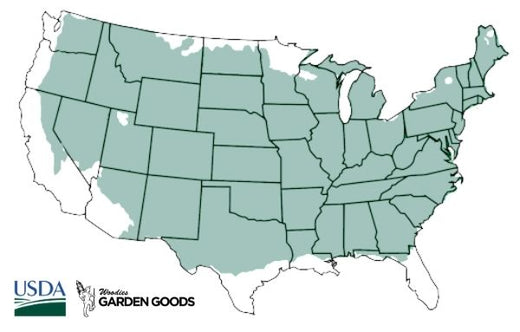
| Hardiness Zone: | 4-8 |
|---|---|
| Mature Height: | 12 to 18 Inches |
| Mature Width: | 18 to 24 Inches |
| Classification: | Perennial |
| Sunlight: | Full Sun |
| Habit: | Upright, clump forming |
| Flower Color: | Blue with yellow centers |
| Flowering Season: | Late Summer to Fall |
| Foliage: | Dark green |
| Soil Condition: | Well-drained, average garden soil |
| Water Requirements: | Moderate; water deeply during dry spells |
| Uses: | Borders, containers, cottage gardens, pollinator gardens |
How to Care for Aster Woods Blue
Be sure to read our planting instructions to ensure a healthy and happy Aster Wood's Blue plant for years to come!
How should I plant Aster ‘Wood’s Blue’?
Choose a location with full sun and well-drained soil. Dig a hole twice as wide as the root ball and place the plant so the crown is level with the soil surface. Backfill with a mixture of native soil and compost to improve structure and fertility. Water thoroughly after planting to settle the soil around the roots. Space plants about 18 to 24 inches apart for good airflow, which helps prevent mildew. Apply a 1–2 inch layer of mulch around the base to conserve moisture and reduce weeds, keeping it away from the crown.
How often should I water Aster ‘Wood’s Blue’ after planting?
Water deeply once or twice a week during the first growing season. Consistent watering encourages strong root development and lush flowering. After establishment, Wood’s Blue Aster is moderately drought-tolerant and will thrive with regular weekly watering during bloom. During especially hot or dry periods, check the top inch of soil — if dry, it’s time to water. Mulch helps regulate soil temperature and retain moisture.
When should I fertilize Aster ‘Wood’s Blue’?
Feed in early spring with a balanced slow-release fertilizer or compost. Fertilizing at this time supports healthy root and shoot growth before flowering begins. Avoid over-fertilizing, as excessive nitrogen can reduce bloom production. A midsummer compost top-dressing is often enough to maintain steady, healthy growth throughout the season.

When and how should I prune Aster ‘Wood’s Blue’?
In early summer, pinch back stems by about one-third to promote fuller branching and more flower buds. Deadhead spent blooms during flowering to extend the display. At the end of the season, cut the plant back to just above the ground after frost or in early spring before new growth appears. This simple cleanup helps maintain its compact form year after year.

